6 November, 2001
The first thought of the day, "I don't want to go to Snow Survival School!"
Since it was a requirement before going into the field, I reluctantly put
on full Extreme Cold Weather gear and packed a bag with extra socks,
gloves, fleece pants, and hats. I could already feel the cold creeping in
as I trudged up the hill to the building for Field Safety Training. I
would be living outdoors for the next two days and one night. Since our
group had 21 members, we had two trainers, Ty and Thai (my sea ice
instructor). We were given instructions before loading our gear into a
huge vehicle called a Nodwell. The means for transportation in Antarctica
has very little resemblance to our vehicles back home. Each one serves a
purpose depending on the destination.
Today, we are heading to the Ross Ice Shelf to set up our "Home away >from
Home". Meeting the people has been a highlight of my stay in Antarctica.
Snow Survival School only added to the need for bonding together
immediately. The greatest surprise of this whole Antarctic journey was
that I really enjoyed this snow school experience, despite the extreme
cold. Every aspect of this training was a learning experience for me. I
learned how to put together and light a small camp stove, set up a two-man
tent, use a "trucker's knot" and a "clove hitch" to secure the Scott tent,
saw blocks from the snow to make a snow wall, and build a "snow dome" for
sleeping. The weather cleared to be a nice day. We were warm as long as we
were working. The weather started to change around dinnertime. The
temperature dropped as the instructors left us to survive the night in our
tents. We lit a stove inside of one of the snow-walled areas. We ate our
lukewarm backpacker's dinner, trail mix, and chocolate candy bars. We were
instructed to eat a lot of calories and stay well hydrated in order to keep
warm. By bedtime, the wind was blowing so hard, it hurt to stay outside. It
was beautiful watching the snow being swept across the surface as it
snowed on us today. The poor visibility later in the day made it difficult
to see the mountains or the instructor's hut in the distance. As I looked
around our "camp", I had the unforgettable feeling of stepping into a
National Geographic picture. Due to the extra layers of clothes, it took
30 minutes to get zipped up into the issued sleeping bag. Getting
overheated before climbing into the sleeping bag actually kept me warm for
the rest of the night. I was so tired that I didn't even notice the light
outside as I quickly fell asleep. Being light 24 hours a day hasn't
bothered my sleep patterns yet. I am averaging about five or six hours of
sleep a "night". After attending Snow Survival School, I will rest easy
knowing that I am better prepared to face future challenges in Antarctica.
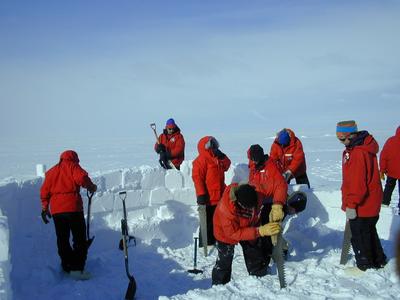
We spent many hours sawing and positioning snow blocks around the two-man tents in order to shield the tents from the wind. My friend, Liz Karr, provided this photo, as well as the next two photos. I lost the digital photos from my snow school experience during a transfer from my camera to the computer. Antarctica is teaching me to "learn quickly". The cold conditions and the loss of power are not always conducive to picture taking. I have to continually remind myself that I'm not at home anymore. Things work differently in Antarctica.
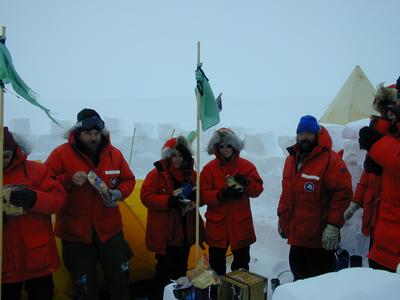
The weather had drastically changed by dinnertime. It was cold as we ate dinner within the snow walls, yet it was absolutely beautiful. I couldn't help but feel that I was experiencing a "National Geographic moment".
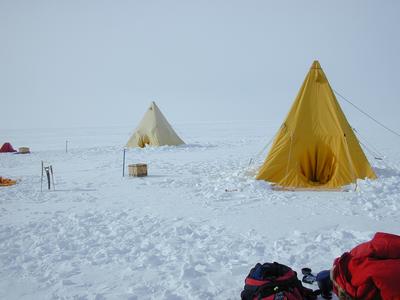
We also spent time setting up two Scott tents, two-men tents, and building a snow dome for our overnight stay on the Ross Ice Shelf.
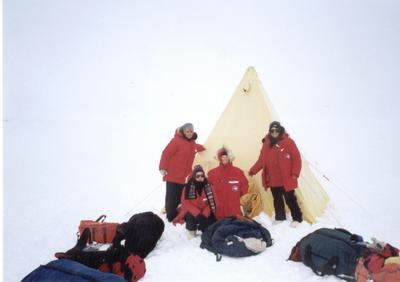
This Scott tent slept three comfortably. Liz, Juliette, and I pulled all of our gear inside the tent with us. When we woke up the next morning, the water in my water bottle had frozen solid. I was surprised how much I enjoyed this experience, and how quickly we all bonded.
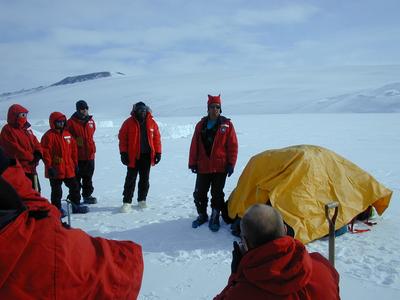
Liz Karr also sent me photos of the snow dome that our group made. In this photo Thai is giving our group instructions on how to begin. We first put our bags under a yellow tarp. Next we will cover the tarp with snow.
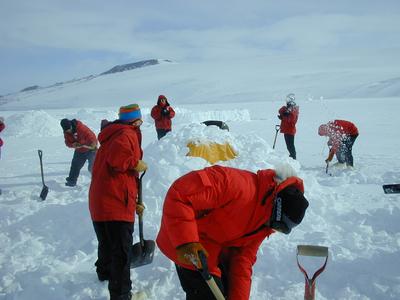
Everyone took turns throwing the shoveled snow on top of the tarp. This process took time, but the snow was so easy to shovel.
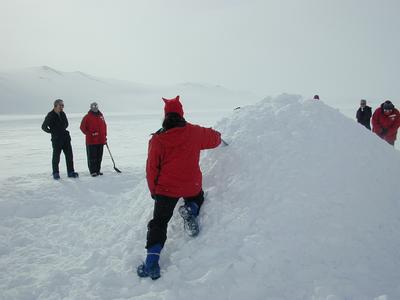
Thai, our instructor, is testing the snow dome to check the depth. The snow must be as deep as the ice pick in order to be safe.
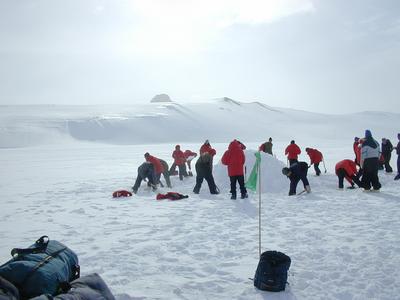
We packed down the snow with our shovels in order to strengthen the snow dome. Then additional snow was added until we got the desired depth.
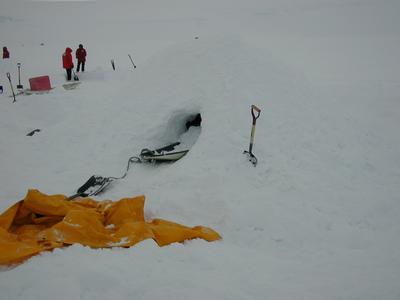
When the outside was finished, the bags and tarp were pulled out of the dome. An entrance was tunneled out of the snow, which led up into a room for two.
Contact the TEA in the field at
.
If you cannot connect through your browser, copy the
TEA's e-mail address in the "To:" line of
your favorite e-mail package.
|
